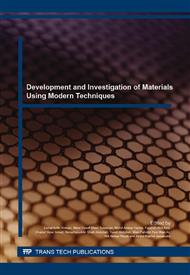p.231
p.236
p.240
p.247
p.252
p.257
p.262
p.267
p.271
Growth of Nanostructured ZnO Nanosheet on ITO/PET Substrate Prepared via Sol Gel Spin Coating and Hot Water Treatment
Abstract:
Zinc Oxide (ZnO) is well known for its wide band gap semiconductor with large excitation energy that serves various application. These unique characteristics had gained much research attention on ZnO nanostructure synthesis and physical properties. In this study, ZnO thin films were deposited on ITO/PET substrate by a spin coating sol-gel process. The starting solution were prepare by dissolved zinc acetate dehydrate (ZnAc) and diethanolamine (DEA) in water (H2O) and 2-propanol (2-PrOH). Acid Citric (C6H8O7) from 0.2 to 1.0 M were dropped into 100 ml sol-gel solution to study effect of sol-gel environment condition. ZnO thin films were obtained after pre-heating the spin coated thin films at 100 °C for 5 minutes after each coating. The coated substrates were undergone for Hot Water Treatment (HWT) process at 90 °C for 6 hours to grow ZnO nanostructures. The effects of sol-gel environment condition by drop different concentrations of C6H8O7 into the solution were studied. Nanoflakes ZnO were obtained after hot water and hydrothermal treated at 90 °C for 6 hours with 0.2 till 1.0 concentration of C6H8O7 dropped directly in the sol-gel solution. On the basis of the changes in morphology and microstructure induced by hot water treatment, it is concluded that the nanosheets were highly transparent with the visible range (350 – 800 nm) with 70%-90% of Transmittance spectra. Growth of ZnO nanosheet influenced by increment of C6H8O7 mol concentration also with value of roughness RMS.
Info:
Periodical:
Pages:
252-256
Citation:
Online since:
January 2016
Keywords:
Price:
Сopyright:
© 2016 Trans Tech Publications Ltd. All Rights Reserved
Share:
Citation:


